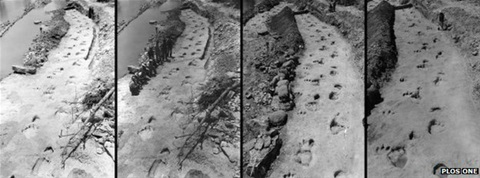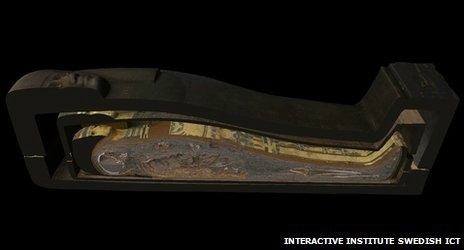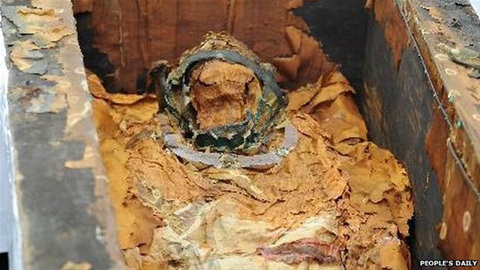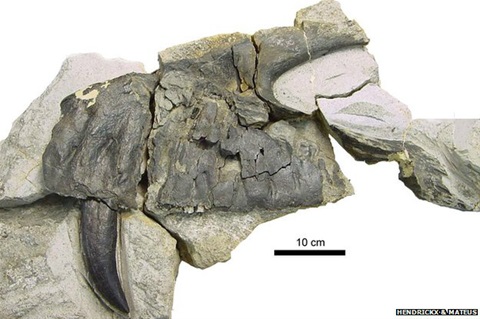Monument Status For Wreck Of Ship Off Bamburg
The remains of the wooden vessel , which lay about 2,130 ft (650km) off Bamburg Castle , were exposed last year after a tidal surge
A Maritime Archaeology sea trust ( MAST) study suggested the vessel dated from about 1770 and was probably English
The wreck now has added protection , making it an offence to damage it , an English Heritage spokesman said "lost and wrecked vesels of the period 1500 to 1815 in English waters are relatively rare , and number fewer than 100
Despite the effects of weathering , a significant portion of the vessel survives and it retains a number of key characteristic features , it has considerable potential for providing insight into the late 18th century and later boat construction materials and techniques , and for coastal trade during this period
The coastal trade was a once prolific and highly significant part of expantion and development of England's merchantile trade
Protected Status For Northumberland's Prehistoric Rock Art Carvings
Mysterious carvings that have lain in the Northumberland countryside for nearly 6,000 years have been given protected status
Created in the Neolithic and early Bronze age , 3800 B.C. to 1500 B.C. ,the origin of the rock art which is older than the pyramids has kept Archaeologists guessing for centuries
Etched on to natural stone surfaces , they are predominantly found in the countyrside , some think they are markers used on the margins of landscapes , some think they implacate the change over from when hunter/gatheres became pastoralists and formed a different relationship with the land , and some believe they could even have a ritual or sacred meaning
The intriguing and abstract carvings share some motifs and are found throughout Northern Europe , the curious marks vary from somple , circular and hollows known as cups, rings and grooves , and often appear singly or in small groups over a large surface area
According to English Heritage , more than 5,000 separate rock sites are known in Britain , with the majority found in upland areas in the North , in Northumberland there are about 1,200 carvings , mainly in the countryside , but some on display in museums
The challange is to link the rock artwork with other excavations in the surrounding area , the rock art may also be found in Yorkshire , Cumbria and Durhen , it seems to be a Northern phenomenon but we don't know why that is the case , the U.K. is quite unique internationally as the carvings are a soley geometric tradition , where as in other parts of the world they seem to be more about people
Now , 17 example of rock art in Northumberland have been scheduled as ancient monuments by the department of Culture , media and port the sites , which can be found found in Lemmington Wood , Well hope , Whitsun bank and Goats Crag were declared thanks to the work of about 100 volnteers from the Northumberland and Durham rock art project (NCDRAP) supported by English Heritage
The new designated sites are well preserved , displaying a wide range of motifs the carvings have survived for 6,000 years and that is impressive , there is something that has been on the land for that time
Modern Lion's Origin Revealed By Genetic Analysis
Unravelling the history of the Lion has been difficult , animals living in tropical areas tend to leave fewer fossilised remains behind
Lions have also been persecuted during their recent history , with whole populations being wiped out by human activity
Such gaps in the fossil record and the distribution of lions , makes it difficult to reconstruct their past
So an international team of scientists turned to the ancient DNA within lion specimens held in collections and museums around the world
The team sequenced DNA from specimens including the extinct Barbary Lion of Northern Africa and the extinct Iranian Lion
The Study revealed that the single species of lion that persists today ; Panthera leo , first appeared in Eastern and Southern Africa
Around 124,000 years ago in the late Pleistocene era , about the same time tropical rainforests expanded across equitorial Africa , at the end of the Pleistocene lion's left North Africa and eventually reaching as far as India
Around 51,000 years ago , the continent dried and the Sahara expanded , cutting off lions in the West from those in the North
Another detail revealed by the study is that modern lions began their exodus just 21,000 years ago , much later, just around 5,000 years ago another group of lions left the continent , reaching what today is Iran in the Middle East , these lions are now extinct
THE LIONS OF BRITAIN
Two Barbary lions once held in Britain's Tower of London have helped to reveal the origin of modern lions , the skulls of these lions were found preserved in the tower's moat
Dating as living in the 14th and 15th centuries , they are the earliest recorded lions in the British Isles since the extinction of the Pleistocene cave lion
Volcanic Islands Merge In Pacific Ocean
A volcanic island in the pacific ocean has merged with it's neighbour to form one land mass
The merged island lies some 621 miles (1,00km) South of Toykyo , the result of erruptions on the sea floor that have spewed enough material to rise aboye the water line
In November 2013 , q new island sprouted near Nishino-shima , another volcanic land mass which last expanded in the 70's
Four months later , the new and old island are one island the newer portion of the island , which is referred to as Niijima , is now larger than the original Nishino-shima land mass , the merged island is slightly more than 13,280 feet across (1km)
According tro N.A.S.A two cones have formed around the main volcanic vents and stand more than sixty meters above sea level , volcanic lava flows are rported to be most active now on the South end of the island , the new land mass lies in the Ogasawara (BONIN) island chain
Ecuador Volcano Throws Up Spectacular Ash Plume
A volcano just South of Equador's Capital City Quito has erupted, creating a spectacular plume of ash six miles in height , the Tungurahua which in the Quechua language means 'throat of fire', and stands 16,500 feet ( 5,029 meters)
The volcano created the huge cloud on Friday in an eruption which lasted only five minutes , Tungurahua has been erupting since 1999 , but has been particlarly active in the last two months , it is one of eight active volcanos inn Equador, which is in the so called Ring of Fire
Multiple villages are located in the vicinity of the volcano , in 2006 six people in one such village were destroyed by lava from the volcano
Dinosaur Tracks , Prehistoric Chase Scene Reconstructed
The tracks were left by two dinosaurs more than 110 million years ago , 70 years ago the whole trackway was removed from thr river bed and divided into blocks , which were moved to different locations for study , some of those blocks werelost , but the team managed to use old photographs to reconstruct the site
The tracks are from two dinosaurs , a large herbivorous sauropod , and a carnivorous theropod , the group of top predators to which Tyrannosauurus rex
In some places the theropod tracks are in the sauropod tracks , this means the theropod came after , which figures the theropod was chasing the sauropod , dinosaurs left lastng prints only when conditions were just right , dubbed the "goldilocks effect" Scientists say that soil conditions had to be perfect for different dinosaurs to leave fossil prints behind , dinosaurs ranged vastly in weight from Brachisaurus weighing aroundd 30 tonnes , to the Compsognathus , which was the size and weight of a chicken
It was found that heavier dinosaurs only left lasting tracks in thick shallow mud , while only lighter dinosaurs could leave prints in deeper shallow mud
Scientists Film Inside A Flying Insect
Scientists from the U.K. and Switzerland have used very intense X-rays to film inside an insect's body as it flies
The resulting footage a 3-D reconstruction made up of several X-ray snapshots , shows a blowflys flight motor , the "muscles and hinges" that power flight , researchers say the insights could be useful for the design of mini air vehicles
The research team noted extremely rapid moveme nts , in the time it takes a human to blink , a blowfly can beat it's wings 50 times
The X-rays were also focused on to a very small area , which was necessary to achieve high resolution of such a small object, the scientists tethered the tiny fly to a vertical mount , which they rotated as the insect was X-rayed
By combining rapid snapshots of the insect's body , the researchers produced a 3-D reconstruction of a blowfly in flight , the X-rays also enabled the researchers to see through the insect's thorax , revealing the power muscles
Scientists in the U.S, have already built the worlds smallest flying robot , copying the high speed motion of a flys wings , the hope is that these could navigate disaster zones , moving through tiny crevices to locate survivors , these "robo flies" however have to be tethered to a proper power source , snd it remains an engineering challenge to make micro scale flying vehicles that are much more efficent at converting "fast , small amplitude , linear , three dimensional motions
Bighorn Sheep Went Extinct On Califorinia Gulf Desert Island
Using ancient DNA analysis and other techniques , a research team led by Conservationist Biologists at U.C. Riverside ,has determined that bighorn sheep , so named for their massive spiral horns , became extinct on Tiburon Island , a large and mostly uninhabited island just off Sonora Mexico , in the Gulf of California , sometime within the last 2,000 years , specifically betwweeen the 6th and 19th centuries
Conventional wisdom amongst wildlife boiogists and the indigenous Seri people , who long inhabited this costal desert region was that the bighorn sheep had not occupied the island prior to 1975 , when for breeding twenty of these sheep were deliberately introduced , which by the mid 1990's the herd had grown in size to five hundred
The research got its start , when in spring 2012 two Seri Grad students made an incidental discovery of a 1500-1600 year old urine cemented dung mat on the floor of a small cave in the Sierra Kunkaak , a rugged mountain range on the Eastern side of Tiburon Island
Subsequently , a Paleontologist Jim Mead used his extensive dung collection of both living and extinct herbivores to determine that bighorn sheep formed the ancient dung mat
Using Mitrochondrial DNA from the ancent sheep pellets , the ancient sequences differed substantially from other larger herbivores which may have been present at the time , further the DNA sequences were not identical with that of the modern day bighorn sheep
Bronze Age Transport Route 'Found During Crossrail Dig'
Wood found during excavation work for Crossrail could be evidence of a 3,500 year old Bronze age transport route through London
Archaeologists examining a site in Plumstead have been searching for the pathway , which ran along the same route of the new rail link in East London
They have unearthed wooden stakes which they say may have been used in the construction of the transport link , excavation at the Plumstead tunnel entrance began last month and results of analysis carried out on items found there recently confirmed them to be of Bronze age in origin
The Crossrail archaeologists say the large network of timber pathways gave Bronze age hunters easier access to the wildlife living on the areas lush wetlands
Amongst the artifacts found so far are Medieval human bones found at Liverpool Street , a rare amber and a piece of Mammoth jawbone
Black Death Skeletons Unearthed By Crossrail Project
Skeletons unearthed in London crossrail excavations are Black Death victims from the great pandemic of thee 14th century
Their teeth contain DNA from the Plague bacterium Yersinia pestis and their graves have been dated at 1348-50 , records say thousands of Londoner's perished and their corpses were dumped in a mass grave outside the city , but its exact location until now was a mystery
Archaeologists now believe it is under Charterhouse Square near the Barbican , they plan to expand their search for victims across the square , guided by underground radar scans , which have picked up signs of many more graves
Lead archaeologist Jay Carver said " this discovery is a hugely important step forward in documenting and understanding Europe's most devastating pandemic"
In March of 2013 Crossrail engineers uncovered 25 skeletons in a five point five meter wide shaft along with pottery which dated from the mid 14th century , they determined the burial ground was used in at least two distinct periods, the earlist being the Black Death of 1348-13350 , followed by a later outbreak in the 1430's
The skeletons provide a rare opportunity to study the medieval population of London , according to Osteologist Don Walker of the Museum of London Archaeology
New Human Species Identified From Kenya Fossil
Researchers studying fossils from Northern Kenya have identified a new species of human that lived two million years ago
The discoveries suggest that at least three distinct species of humans co exsisted in Africa ,Anthropologists have discovered three human fossils that are between one point seventy eight and one point ninety five million years old , the specimens are of a face and two jawbones with teeth
The finds back the view that a skull found in 1972 is of a separate species of human , known as Homo rudolfensis the skull was markedly different to any others from that time , it had a relatively large brain and long flat face
But for 40 years the skull was the only example of the creature and so itt was impossible to say for sure whether the individual was unsure specimen or a member of a new species
With the discovery of the three new fossils , researchers can say with more certainty that Homo rudolfensis really was a separate type of human that exsisted around two million years ago alongside other species of humans
For a long time the oldest known human ancestor was thought to be a primative species of human called Homo erectus , they had small heads and prominent brows and stood upright
But 50 years ago researchers discovered an even older more primative species of human called Homo habilis that may have co existed with Homo erectus , now it seems Homo rudolfensis was also around , and raises the distinct possibility that many other species of humans also existed at the time
This find is the latest in a growing body of evidence that challenges the view that our species evolved in a smooth linear progression from our primate ancestors
Our past was a diverse past , our species was evolving in the same way that other species of animals evolved , there was nothing unique about us until we began using stone tools
Humans seem to have been evolving in different ways in diffrent regions , it was almost as if nature was developing different human proto types with different attrabutes , only one of which , an ancestor of our species was ultimately successful in evolutionary terms
Conflict And 'Boom-Bust' Explain Human's Rapid Evolution
What explains the exrtaordinary fast rate of evolution in the human lineage over the past two million years
A leading human origins researcher has come up with an idea that involves aggression between groups and the boom-bust cycles that have punctuated our spread into new inviroments , Prof. Ian Tattersall said there were few examples to rival the accelerated evolution that led to our species
"However you slice it , evolution within this (Human family) has been very rapid indeed" Prof. Tattersall speaking at this years Calpe Confrence in Gilbraltar said
I think it's fair to say that our species Homo Sapiens and it's Antecedents have come much farther , much faster than any other Mammalian group that has been documented in this very tight time frame"
Among our Ancestors , brain size doubled between one and two million years ago , then it has almost doubled again between one million years and the present day , the increase in brain size seems to have coincided with a modern physique characterised by a liner shape , long legs and relatively narrow hips , these features can already be seen in the skeleton of the "Turkana boy's Antecedent "Lucy" (Australopithecus afarensis) who lived in Ethiopia about one million years earlier
Under natural conditions , it is very hard to see how the initial invasion of the new ecozone by hominids could have so consistently driven rapid change over the long period of time taalked about
Certain evolutionary psychologists have popularised a model in which culture and brain complexity spurred each other on to greater heights
In humans aggression between small , distinct human groups in the past is one of the major remaining agents of such change inter-group conflicts would certainly have placed a premium on such correlates of neural function as planning and throwing
Culture , in the form of clothing , fire use and the construction of shelters , has allowed humans to expand into enviroments that their relatively frail bodies could not otherwise have coped with
But both culture and techonolgy have their limits , and relatively good climatic conditions would have favoured population expansions , this made the artificially enlarged ancient human populations vulnerable to fragmentation when enviromental conditions worsened
During the onset of an ice age or drought , human populations would have contracted, driving the remaining small isolated human groups to diversify and develop different biological traits from one and other
The wild environmental fluctuations in Pleistocene times , from about 2.5 million to 11,000 years ago would have provided the ideal conditions for this to happen , when conditions improved again , populations that had developed different characteristics would have come into contact again , this might have increased the likelihood of competition between distinct groups , but also allowed genetic novelties to spread , that would not have arisen without the initial fragmentation
Living Materials Could Grow Products
In future , complex and inter active structures could be grown using cells programmed to assemble into intracate patterns their researchers argue
They describe patterned biofilms made from proteins tougher than steel , designed to incorporate semi conducting crystals and electrical wiring
The living biofilms are the creation of synthetic biologist timothy Lu and his team
" Just imangine what we could achive if we could grow physical devises and strucures from the bottom up using cells and minimal inputs , rather than manufacture and shape them from the top down"
Monster Turtle Fossils Re United
Atlantochelys Mortoni , was originally described from a broken arm bone or Humerus , found in the 1840's in the U.S. State of New Jersey
Remarkably the missing portion has also now been unearthed , the fossil fragments are a perfect match and indicate Atlantochelys mortoni must have been some nine feet or three meters from tip to tail
"when we put the halves together , we were astonished " Dr. Ted Daeschler of The Academy of natural Sciences , Drexel University , in Philadelphia
Both parts come from cretaceous sediments , 70 to 75 million years old , in Monmouth County New Jersey , together the bone fragments give a much clearer view of Atlantochleys Mortoni , a species that would have loooked very much like the modern day loggerhead , apart from it's size
Frozen Arctic Moss Revived After 1,500 Years
British scientists have successfully revived mosses which have been frozen under the Antarctic ice for over 1,500 years
The researchers thawed out the ancient vegetation and were surprised to see nwe shoots rapidly appear, while bacteria of a simular age have been recovered before , the scientists say , these are the oldest plants to have been brought back to life
Mossy banks are a curious feature of the frozen Antarctic , formed over thousands of years , from accumulation of these tenacious plants that spring to life in the brief Southern Summer
The oldest banks date back over five thousand years , and are useful archive for scientists , of what past climatic conditions have been
The Digital Unwrapping Of Egyptian Priest Neswaiu
In the 19th century and even later there was no shortage of people eager to watch the unwrapping of an Egyptian mummy
As Egyptology and Archaeolgy evolved , the destructive practice came to an end, but it did'nt mean researchers and the public were any less curious about what lies within a mummies wrappings
Now 21st century technology is being used to virtully unwrap mummies , without causing any damage to the body and the wrappings , and now comes a chance for the public to digitally unwrap a mummified body themselves
Neswaiu lived in the third century B.C. at the temple of the god Montu in Thebes , present day Luxor
Anzu Wyliei : Scientists Announce New Dinosaur Discovery
U.S. Scientists have announced the discovery of a new species of dinosaur , it's fossils offer further clues to how the dinosaurs became extinct 66 million years ago
Anzu Wyliei is a strange , bird like creature that has a bony crest on top of a beaky head and a long tail like a lizard
The animal was identified from the partial remains of three skeletons collected in North and South Dakota
Anzu is really bizarre , even by dinosaur standards , the skull has this extraordinarily tall and thin crest with a snout and a huge beak with sharp edges and a strange sliding jaw joint , that could be used to cut up vegetation and meat
The size of a small car , the dinosaur also had claews and feathers on it's upper arms , it belongs to a group of dinosaurs known as Oviraptorosauria , most of theie existence comes from fossils discovered in Central and East Asia
The Anzu bones are the first detailed evidence that Oviraptorosaurs also lived in North America
The specimens were found in a geological formation known as Hell Creek , which has been extensively explored and is the source of many dinosaur fossils discovered in North America
Scientists have nicknamed it " The Chicken From Hell" because of it's appearance and where it was found
The site is important because it was formed in the last two million years of the Cretaceous Period , just before dinosaues were wiped out by an asteroid strike
This is consistant with the idea that a mass extinction was caused by the great asteroid impact 66 million years ago , it's clear that dinosaurs were still quite diverse until the very end
Ancient Earth Hammered By Double Space impacts
We've all seen the films where an asteroid hurtles towards our planet , threatning civilisation, what's less well known is that menacing space rocks sometimes come on pairs
Researchers have outlined some of the best evidence yet for a double space impact , where an asteroid and it's moon apparently struck Earth in tandem
Using tiny plankton like fossils , they established that neighbouring craters in sweden are the same age , 458 million years old
However scientists cautioned that seemingly contemporary craters , could have landed weeks, months or even years apart , a handful of possiable double impacts (or doublets) are already known here on Earth , but Dr.Jens Orno says there are disputes over the precision of dates assigned to these craters
Double impact craters must be of the same age , otherwise this could just be two craters right next to each other
Binary asteroids are thought to form , when so called "rubble pile" asteroid begins too spin so fast under the influence of sunlight that loose the rock is thrown out from the objects equator too form a small moon
Skull Fragments Reveal Ancient Crocodile Species
Two fossilised skull fragments from a two foot (60cm) Crocodile found on the Isle of Wight , point to the discovery of a new ancient speccies , a study has found
The pieces , a snout and back part of the skull , were found by two diffrent private collectors , some three months apart
Experts at the Dinosaur Isle Museum near Sandown , found the 126 Million year old fragments "fitted together perfectly to make a complete skull"
The species has been named : Koumpiodontosuchus Aprosdokiti , the meaning "unexpected button toothed crocodile, was given by University of Portsmouth Palaeontologist Dr. Steve Sweetman
Dr. Sweetman said " both parte of this wonderful little skull are in good condition , which is most unusual when you consider that the crashing waves usually batter and blunt the edges of fossils like this within days or even hours of them being washed onto the beach
"Both parts must therefore have been found very soon after they were released from the mudand debris , originally laid down on a Dinosaur trampled river flood plain about 126 million years ago"
China: Ancient Coffin Rescued From Tomb Raiders
Chinese Archaeologists have "rescued" an ancient coffin from tomb raiders trying to break into a grave site via a ten meter hole
The 1,500 year old , pinewood coffin was found in a tomb , in pasture land in the Northern Inner Mongolian region , and dates from the Northern Wei Dynasty between 386 and 535 A.D. , inside scientists found the remains of what appears to have been an Aristocratic woman , wearing silk clothing , fur boots and a metal headband
The well preserved remains will enable archaeologists to study the funeral customs of the Xianbei Nomadic groups , who lived in Northern China at the time, hair samples will also allow forensic analysis of the womans age and diet
The area appears to be an important burial site for aristocrats of that period
Ferocious Dinosaur Was European Giant
Scientists in Portugal have identified what they think may have been the largest predator ever to roam across european land mass
Fossil bones from the dinosaur were pulled from a cliff at Praia Da Vermella , just north of Lisbon
Known as Torvosaurus Gurneyi , this ferocious beast would have been some ten meters in length and weighed perhaps four of five tonnes
It was a theropod , the kind of two legged , meat eating animal that everyone instantly recognizes in something like the Tyrannosaurus Rex
But the Torvosaurus Gurneyi lived much earlier , about one hundred and fifty million years ago , at the time that the T-Rex roamed the Earth , the Torvosaurus was already a fossil , some eighty million years seperate the two species




















